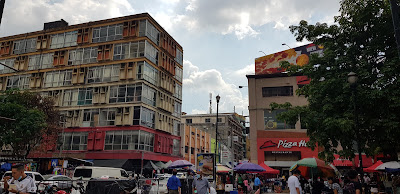
It wasn’t until a friend commented on my San Pedro Sula selfie that I got an idea about how dangerous the city could be. I thought the unenviable distinction of being the Homicide Capital of the World was monopolized by Tegucigalpa, another Honduran city. And so, I looked it up and found some articles about the world’s most dangerous cities and how SPS was the Murder Capital of the World in 2019. Wow, Honduras. Murder and Homicide, eh? Must be fun, those hobbies, for you to excel in both.

But I haven’t been murdered yet. Writing this article in hindsight, I’m already five hours away by bus in Honduras’ third largest city, La Ceiba. As to what distinction La Ceiba has, I no longer want to find out. But if and when I do, let’s talk about that in the La Ceiba article. For now, let’s talk more about San Pedro Sula. Around 4 hours away by bus from Tegus, SPS is the capital of the Caribbean department of Cortés. SPS is a bit more inland, but the department does have some areas jutting out to the Caribbean Sea.



Since Tegus and SPS are the country’s largest and second biggest cities, there are bus connections aplenty as well as mini vans plying the route. Coming from Comayagua, all I had to do was wait at the highway connecting the two cities and flag a bus. The first one that stopped was full and standing room only. The second one came after 20 minutes or so and, to everyone’s delight, was relatively empty. The bus ride cost HNL100 (~PHP210) and the ride took more than four hours because the bus was stopping everywhere.

And so, what is my impression of SPS? Well, first stop, I’m glad I didn’t get murdered. The thing is, though, I didn’t feel threatened in any way when I was there. The most common annoyance I encountered was the feeling of being an animal at the zoo, with people staring at me because I seemed to be the only Asian in town. I obviously wasn’t, but I was probably the only one sightseeing that day. The city’s layout is more straightforward than Tegus. You have a circular main road enclosing most of the city center which makes it easy to spot different locations on Google Maps.

The Airbnb I got was another hit, located just across Hilton Princess and Hyatt. In short, the area was very touristy, with a lot of restaurants lining up the avenue with those verdant hills in the background. There’s even a hospital across the street! In short, I felt very safe and was even surprised when I found out about the entire Murder Capital 2019 tag associated with the city. As I ventured farther downtown, though, people started multiplying and I felt a bit uneasy, but I always get that feeling in crowded places anyway.



The department of Cortés has a lot to offer in terms of nature hikes and beaches given its strategic location. For example, you can go to Puerto Cortés along the Caribbean coast if you want to go to the beach. San Pedro Sula also has the country’s most accessible airport with flight connections to the US and Europe, as opposed to Tegucigalpa’s Toncontín which is considered to be the most dangerous in the world, not because of homicide but due to its crash-prone terrain. Time will tell if the newly opened Palmerola airport in Comayagua can rival SPS’. For now, it’s best to land at SPS coming from outside Honduras.

As for San Pedro Sula itself, it’s a livable city that I wouldn’t mind relocating to for a month or so. I believe it is either Tegus or SPS that is the main option for residence for many people, locals and tourists alike, because of the opportunities they offer. But of course, along with that come chaos and crime. As tourist destinations, I’d say just land here and skip the city for more touristy locations such as the Bay Islands. But if you are moving to Honduras, then either SPS or Tegus should be on top of your list.









0 creature(s) gave a damn:
Post a Comment